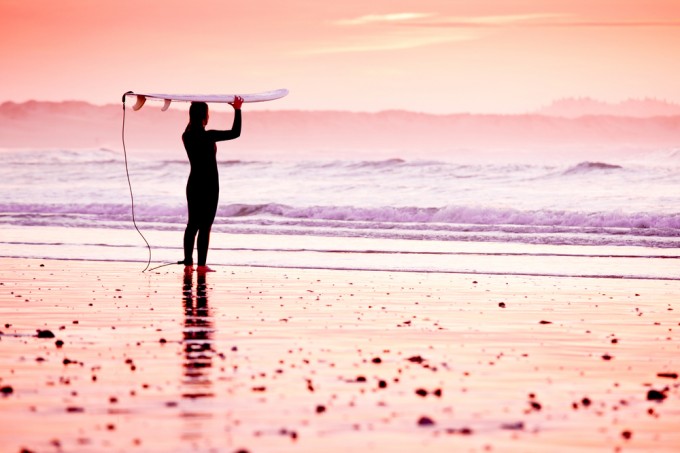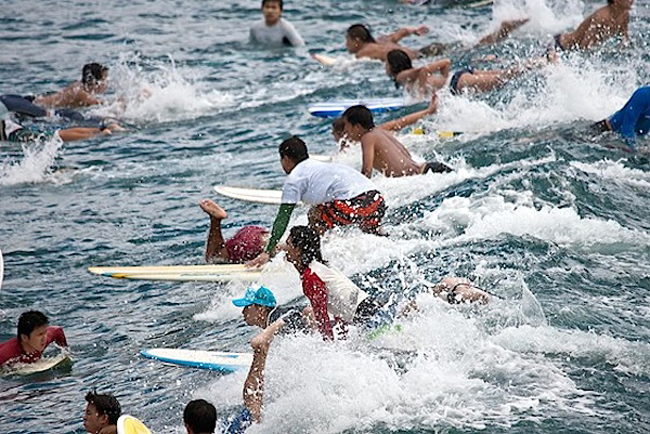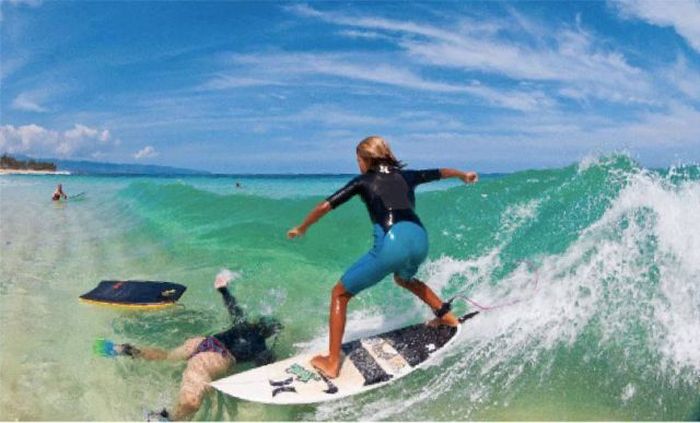
Surfing doesn’t have rules. At least none specifically written down. However, when you’re out back with twenty other people, it’s probably a good idea to know what you should and shouldn’t be doing.
So, here it is – our A to Z of surf etiquette. Hopefully it will help – or at least prevent you from getting beaten up one day…
A – Amping
The term used in surfing to describe a state of hyper excitement. It has recently been superseded by the term “froth”, as in frothing hard. While amping for a surf is a good thing, surf etiquettes stipulates that you mustn’t over-amp. This is bubbling over of froth levels of snaking, dropping in and hassling, all terms that will be explained in excruciating detail below.
B – Bail
To bail is the act of jumping off your board when a wave approaches, swimming down under the wave, rather than staying attached to your board and using the common duckdive technique to get through the whitewater.
It is only an acceptable practice if you are:
a) under ten years of age
b) the oncoming wave is bigger than a house.
This is mainly because bailing is a dangerous act, as your board is left flailing behind you with a very good chance of clocking another surfer in the head.
Sometimes attempting a duckdive may leave you shaken to the core and 50 metres closer to shore than when you started, but that is a small price to pay for knowing you have chose the ethically, morally and etiquettically correct approach.

C – Caught Inside
See Bail.
D – Drop In
A drop-in, the act of catching a wave when another surfer is already surfing a wave, is the single largest transgression against etiquette in surfing.
Unlike most of the other unwritten rules in surfing, this rule is fairly black and white. The surfer on the inside (or closest to the breaking part of the wave) has priority. Once that surfer is up and riding, you must not to interfere in any way.
To do so is to break a fundamental rule, akin to driving around in a car and ignoring red lights. If we all did it, anarchy and certain death, would result.
E – Etiquette
A vague set of unwritten rules that allow surfers to operate in an ocean environment.
While surfing etiquette can vary from country to country, or even beach to beach, the basic principles allow surfers to go about their surfing without official regulation and writers like me to write extended articles about the so called unwritten rules of surfing.
F – Fight
See Localism.
G – Goofy
A goofy footer is a surfer who surfs with his right foot forward.
Originally seen as the minority in the sport and slightly denigrated (the left foot forward surfers are called the much less offensive natural or regular) goofy footers have fought back over the years, with famous goofys like Tom Carroll, Mark Occhilupo and current world number one Gabriel Medina leading the way.
Still, it remains one of the most divisive issues in surfing and like politics, religion and stand up paddleboarding, should never be brought up at the surf camp dinner table.
H – Hassle
The dark art of hassling is a mysterious beast and very hard to get a handle on.
To hassle is to be slightly aggressive in your pursuit of waves and to push the boundaries of the blurred lines of surfing etiquette. It involved a constant quest to paddle to the inside (see below), to never be happy to wait your turn and to never let your fellow surfers relax for a minute.
In super crowded lineups, it is almost mandatory. However problems arise when surfers bring that hassle mentality to mellower, less crowded line ups. In the end by hassling you may get more waves, but you’ll have fewer friends.

I – Inside
The inside most commonly refers to pole position in the lineup. The surfer closest to the breaking part of a wave who therefore has first priority.
In an ideal world, some type of queuing system takes place, where surfers remember who has been on the inside the longest. It is kinda like waiting for a drink at a packed bar, with people jockeying to get the front.
Of course, like at the bar, sometimes people shove to the front quicker and often don’t acknowledge who has been waiting longer. This is very annoying. Such is life.
J – Jump Off
Many surf spots have a place where a jump off the rocks will negate the need for a long paddle out from the beach. It can be a risky manoeuvre, but an option that should be always exercised.
Not only do you save yourself a long paddle, but you gain a sense of self accomplishment, even before you catch your first wave.
Unless of course you mistime your jump and end up bleeding, humiliated and with the added bonus of a damaged board adding insult to injury.

K – Kook
A historic term originally used for someone who lacked a natural ability for surfing.
Slightly unfair on those who have just taken up the sport, although being a kook can also be applied to good surfers who exhibit poor behaviour, such as incorrect fashion, poor choice of equipment or ginger hair.
Still considered the single biggest derogatory term in surfing and only to be used with real care.
L – Localism
Localism, the care and protection of surf spots by the local surf community, has always been a fundamental part of surfing.
At its best, it fosters a positive community spirit where local surfers look after both the wave and all its participants. At its worst, it uses violent tactics to intimidate any surfers who are not part of the in crowd.
Sadly it is the latter form of localism that tends to prevail, a form of ignorance and close mindedness that shouldn’t be part of surfing. Having said that, if you ever surf my local secret spot, I’ll knock your block off.